Birdfinding.info ⇒ Generally common across most of its range, including most of India’s lowlands, northern U.A.E., portions of northern and southern Israel, and the western lowlands of Taiwan. In Puerto Rico, it is somewhat uncommon and local, but found consistently in the south-coastal lowlands, especially at Cabo Rojo National Wildlife Refuge and La Parguera. In France, the most reliable site appears to be the Var Estuary just west of the Nice Airport.
Indian Silverbill
Euodice malabarica
Indian Subcontinent and Arabian Peninsula; introduced elsewhere.
Brushland, scrub, and agricultural and urban areas from Bahrain to eastern Oman, and from southeastern Iran eastward across essentially all the lowlands of the Indian subcontinent as far as western Bangladesh, and on Sri Lanka.
Introduced populations are well established in: Israel (and adjacent parts of Egypt and Jordan); Kuwait; several urban areas of Saudi Arabia (Medina, Jeddah, Mecca, Riyadh, Damman, and possibly others); the French Rivera (Cannes to Nice, and expanding); and on Taiwan and Puerto Rico.
Contrary to several sources, not known to be established in Hawaii (where African Silverbill is locally abundant).
Identification
A pale sandy-brown, long-tailed finch with a bluish bill.
Its boldest features are a bright white rump and uppertail coverts, and contrasting dark brown or blackish wings and tail.
The face often appears distinctly whiter than the crown.
The flanks are often buffy and subtly barred or scaled.
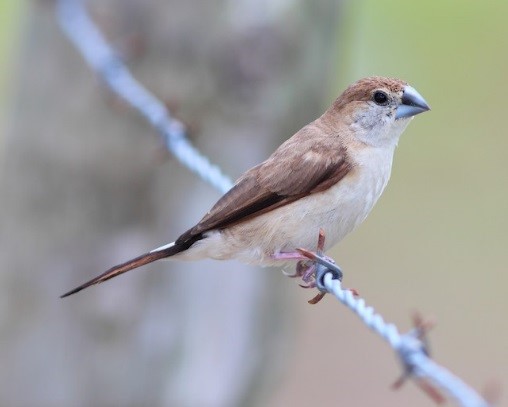
Indian Silverbill. (La Parguera, Puerto Rico; March 21, 2012.) © Alan Selin

Indian Silverbill, showing white rump and subtle barring or scaling on the flanks. (Bhutnal Lake, Bijapur, Bijapur, Karnataka, India; June 28, 2019.) © Ramesh Desai

Indian Silverbill, showing white rump and subtle barring or scaling on the flanks. (Kumbhargaon Bird Sanctuary, Bhigwan, Pune, Maharashtra, India; August 4, 2017.) © Aravind Amirtharaj

Indian Silverbill, showing subtle barring or scaling on the flanks. (Hessaraghatta Kere, Bangalore, Karnataka, India; December 9, 2018.) © Albin Jacob
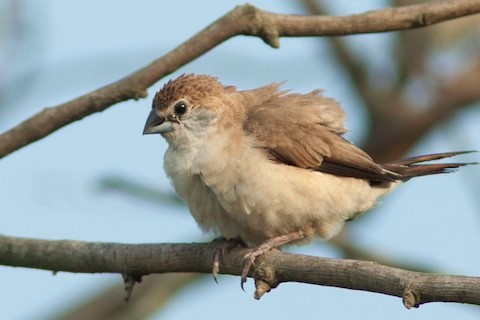
Indian Silverbill, with feathers puffed out. (Belur, Hassan, Karnataka, India; October 15, 2014.) © Vineeth Kumar
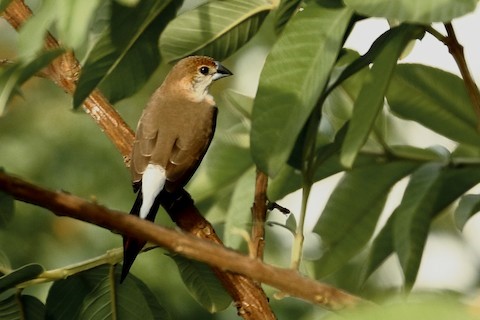
Indian Silverbill., showing white rump, black tail, and warm-brown upperparts (Bharuch, Gujarat, India; June 30, 2019.) © Dr. Sandip Modi

Indian Silverbill, appearing plump and pin-tailed in this peculiar view. (Bhutnal Lake, Bijapur, Bijapur, Karnataka, India; June 28, 2019.) © Ramesh Desai
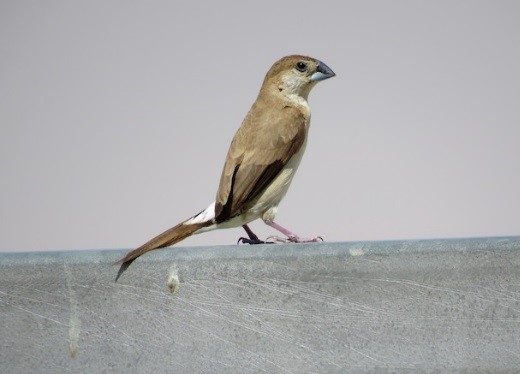
Indian Silverbill, showing white rump and long, dark tail. (Jebel Hafit, Abu Dhabi, United Arab Emirates; April 23, 2016.) © Gary Douglas
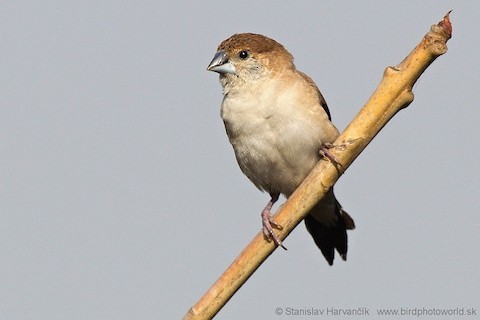
Indian Silverbill, ventral view showing bluish bill and subtle barring on sides, but otherwise nondescript. (Aravalli Biodiversity Park, Delhi, India; March 1, 2019.) © Stanislav Harvančík
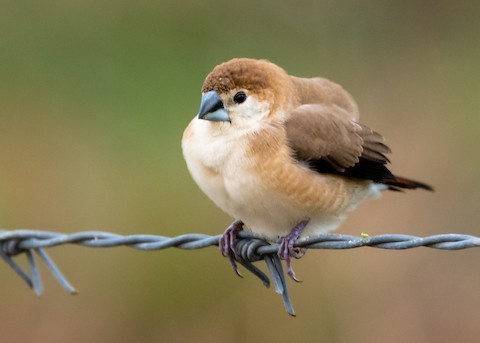
Indian Silverbill, with feathers puffed out, showing subtle barring on the sides. (Bhutnal Lake, Bijapur, Bijapur, Karnataka, India; July 5, 2019.) © Ramesh Desai
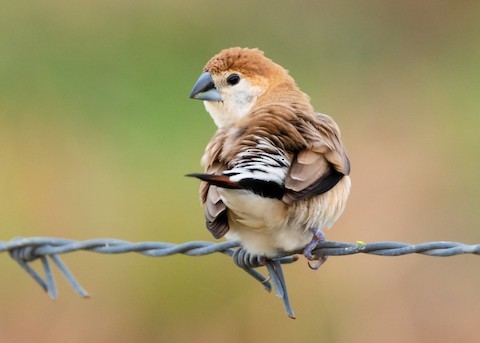
Indian Silverbill, showing whitish face and white rump. (Bhutnal Lake, Bijapur, Bijapur, Karnataka, India; July 5, 2019.) © Ramesh Desai
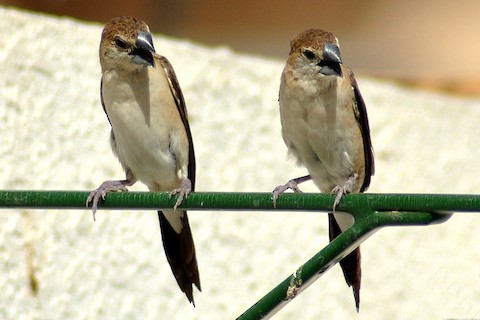
Indian Silverbills. (Sharjah, Dubai, United Arab Emirates; June 4, 2010.) © Robert Erasmus

Indian Silverbills, appearing dark-brown from this perspective. (Arakhiya Farm, Jariyan al Batnah, Qatar; February 20, 2009.) © John Thompson

Indian Silverbill, showing a scaly pattern on the crown. (Dubai, United Arab Emirates; June 5, 2010.) © Robert Erasmus
Immature is plain brown, nondescript, with a dark bill, and lacks the adult’s long tail—and is easily confused with other immature finches.

Indian Silverbill, immature. (Bir Sikhanwala, Faridkot, Punjab, India; November 21, 2017.) © Varinder Naturaphile
Cf. African Silverbill. The natural ranges of Indian and African Silverbills do not overlap, but through introductions they occur together in parts of the Arabian Peninsula. Both are widely kept as cagebirds and either species could turn up almost anywhere.
The clearest difference is the rump: white on Indian, black on African. Subtler differences include the sides and flanks (Indian’s are typically buffy, often with faint pale barring, whereas African’s underparts are whitish throughout) and the upperparts (Indian’s are unmarked, whereas African’s are faintly barred).
In addition, Indian usually shows a contrast between pale, whitish cheeks and its brown crown, whereas African shows either a muted contrast (in orientalis) or none (in cantans). This distinction may be helpful in some cases, but is not 100% reliable as there is a spectrum in both species.
Notes
Monotypic species. Formerly considered conspecific with African Silverbill, together comprising the Warbling Silverbill (Lonchura malabarica).
References
Anonymous. 2018. Euodice malabarica (Linnaeus, 1758) – Indian Silverbill. Birds of India Consortium (eds.). Birds of India, v. 1.66. Indian Foundation for Butterflies. http://www.birdsofindia.org/sp/1384/Euodice-malabarica. (Accessed April 6, 2020.)
BirdLife International. 2018. Euodice malabarica. The IUCN Red List of Threatened Species 2018: e.T22719770A131997686. https://dx.doi.org/10.2305/IUCN.UK.2018-2.RLTS.T22719770A131997686.en. (Accessed April 6, 2020.)
Brazil, M. 2009. Birds of East Asia. Princeton University Press, Princeton, N.J.
Clement, P., A. Harris, and J. Davis. 1993. Finches and Sparrows: An Identification Guide. Princeton University Press, Princeton, N.J.
eBird. 2020. eBird: An online database of bird distribution and abundance. Cornell Lab of Ornithology, Ithaca, N.Y. http://www.ebird.org. (Accessed April 6, 2020.)
Hollom, P.A.D., R.F. Porter, S. Christensen, and I. Willis. 1988. Birds of the Middle East and North Africa. T & AD Poyser, Calton, England.
Kirwan, G.M., A. Levesque, M. Oberle, and C.J. Sharpe. 2019. Birds of the West Indies. Lynx Edicions, Barcelona.
Payne, R. 2018. Indian Silverbill (Euodice malabarica). In: del Hoyo, J., Elliott, A., Sargatal, J., Christie, D.A. & de Juana, E. (eds.). Handbook of the Birds of the World Alive. Lynx Edicions, Barcelona. https://www.hbw.com/node/61179. (Accessed April 6, 2020.)
Raffaele, H., J. Wiley, O. Garrido, A. Keith, and J. Raffaele. 1998. A Guide to the Birds of the West Indies. Princeton University Press, Princeton, N.J.
Restall, R. 1997. Munias and Mannakins. Yale University Press, New Haven.
Xeno-Canto. 2020. Indian Silverbill – Euodice malabarica. https://www.xeno-canto.org/species/Euodice-malabarica. (Accessed April 6, 2020.)

